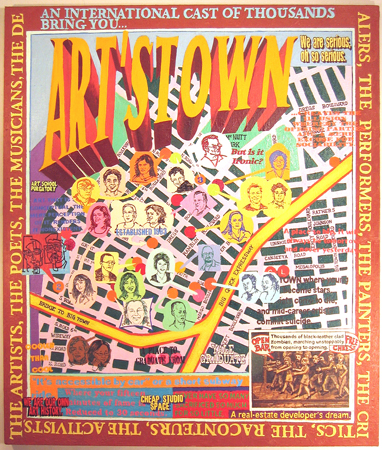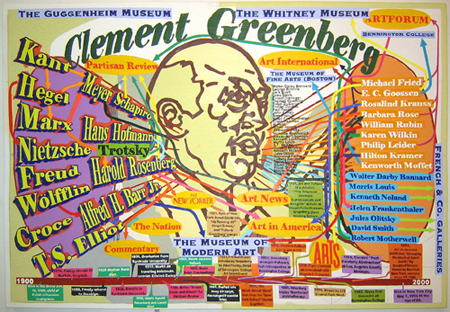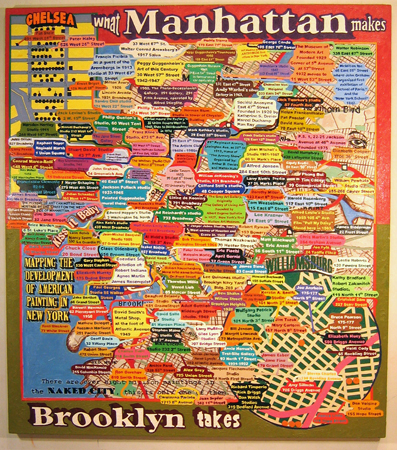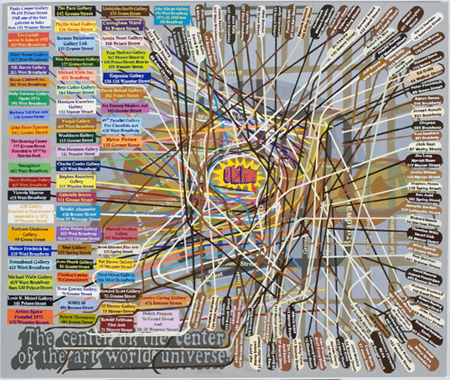I first met Loren, aka his reportage alias James Kalm, online. In fact I’ve only corresponded with him online. But I feel as though I know him through his video reviews of the NYC arts scene. As James Kalm, he rides a bike to the city’s openings, equipped with a handheld video camera, providing the rest of us with a generous dollop of wry wit and an astute critique of the long held center of the art world. Often courageously so, as he’s been not so politely ushered out of museums and recently negotiated a somewhat threatening dispute over his right to video on a gallery’s private property.
Munk paints fascinating geographical histories of the New York arts scene, intricate and brightly colored, with humorous sidebars and captions that offer a deep knowledge of art history and of the artist inhabitants of the city.
For larger views of his work, visit his website.
‘Art’stown’ (2000-2005), oil on linen 68 x 58 inches.
fd: Can you talk a little about your background and how long you’ve been charting artists’ territories, with your distinctive paintings that combine map making, iconography and an almost Mad magazine or Zap comix caption style?  A second part of this question is; how do you know so much about so many artists?
LM: I was born in Salt Lake City in a family descending from some mainline Mormons.  We moved to Idaho when I was ten.  Shortly thereafter I was in Sunday-school and asked an inconvenient question.  They told me not to come back until I stopped making trouble.  I never went back and realized, asking questions is fun.Â
I learned to read maps in the Boy Scouts, and taught classes in it when I was in the Army in Europe, plotting the paths of nuclear fallout.  My tour of duty in Germany is where I got my basic art history, and had the first opportunity to visit great museums in places like Berlin, Amsterdam, Paris and Munich.  Back stateside I decided to become an artist, but there wasn’t any scene to speak of in Idaho, so I came to New York to go to the Art Students League on the GI Bill.  Just as the East Village scene started to pop, I got a job driving the delivery truck for the neighborhood Utrecht art supply store.  I guess that’s when I started to get to know about artists and where they lived.  I’d drive over and drop off their paint and canvas, had to have a list and map in my head and I guess it’s just kept growing.  Besides going to plenty of gallery and museum openings I spend a lot of time studying art history texts, reading old magazines and doing research on the internet. Â
‘Clement Greenberg (Large)’ (2005-2006), oil on linen 48 x 72 inches.
fd: Can you discuss your current work and thought processes. What is the context of your work, do you have any set ideologies as a painter? You’ve said in one interview that ‘painting is the true evolutionary state of alchemy’. Can you expound on this idea?
LM: I’m usually repelled by art theory, but I’ve got one, it’s called “The Physics of Aestheticsâ€. I’m fascinated by how the art world functions, what does or doesn’t get seen, how we come to value certain things and not others, and what forces allow or direct a society’s vision and perception. This is the overarching theme to all the work from the maps and charts, the video documentation to the critical writing. It might be simpleminded, but I think there’s an analogous relation to astrophysics, light being the equivalent of awareness. I’ve been categorized as part of the “Mapping†movement, an “Informationist†or someone making “Meta-artâ€.
As a painter it’s been important for me to engage with history, particularly the New York School and all its derivations. Ad Reinhardt, a great influence, said “Art is art, everything else is everything else,†and “All art comes from artâ€. I’m taking a dialectical approach. Where Reinhardt emptied out his painting, reduced his color, and claimed to be making the “last paintingsâ€, I’m using art, filling the picture with its community and history, using juicy physical color, and saying “painting is just beginning.â€Â
Regarding alchemy, I can’t get too specific because part of the philosophy is its tradition of obfuscation and misdirection. Just as the dinosaurs evolved into birds, the “great work†(alchemy) has evolved into painting, not in a metaphorical way, but in actuality. If you look at the history of chemistry, a lot of it has been devised in the pursuit of pigments, an attempt to satisfy man’s insatiable appetite for color. (For anyone interested in this I‘ll recommend a great book, Bright Earth by Philip Ball.) This is bound to alchemy’s quest for hidden knowledge or enlightenment, the Philosopher’s Stone. What other activity literally reflects the goal of turning dross matter into gold? What other activity can reveal more philosophic or spiritual conclusions? How else can you combine burnt bones, the essence of madder root and rabbit skin glue to drag an image from fantasy into reality? And yet what other practice appears more simple and open to all comers?     Â
‘What Manhattan Makes, Brooklyn Takes’ (2004-2006), oil on linen 72 x 64 inches.
fd: Your work reminds me a little of Red Grooms, you work in a diagrammatic, intensely typographical style also reminiscent of a traditional letterprint shop like Hatch Show Print in Nashville, TN. Who say that ‘Advertising without posters is like fishing without worms’.  Who or what are some of your influences?
LM: As a kid growing up in the 60s, I loved the psychedelic posters and album covers put out by folks like the Family Dog, Rick Griffin, Peter Max, and Victor Moscoso. Underground comics were in the mix with R. Crumb and S. Clay Wilson. For a couple of years while studying at Idaho State, I worked in the poster shop for Student Programming. I designed and printed dozens of posters. This also gave me an appreciation for type and fonts, and a basic knowledge about their potential for emotional resonance. One measure of success was how many of our posters were stolen before the events happened.
Of course I love Picasso, Braque, Gris, all the Cubists and Matisse, the German expressionists, DADA, Duchamp, the Pop artists. I’m a big fan of Kurt Schwitters and his progeny, including Rauschenberg and Bruce Conner. I love the Outsiders and Art Brut artists like Howard Finster, Thornton Dial, Adolf Wölfli, Henry Darger. I find myself becoming more excited by these guys than by the fashionable academically accepted artists that are foisted on us repeatedly by the major museums. Stuart Davis is someone who still inspires me, especially his use of the flat color plane, and I think Alfred Jensen is an artist who still hasn’t been understood enough to see what an incredible breakthrough his work is. I think about a group of “mystical†artists from the “Enlightenment†like Robert Fludd and Jacob Böhme because they were attempting to translate very complex transcendental concepts into fantastic graphic images. A lot of the best abstraction is based on this idea of encoding mystical principles into painting.Â
Having cut my teeth as a Neo-Expressionist and Kitsch artist, I wanted to remove the excesses of the hand from the work, to invoke a kind of Warholian distance, or institutional momentum; to this end, I’ve been using Printshop and Photoshop programs, to help design the pictures. I disagree with Greenberg’s claim that “content is ineffableâ€. I’d like to think that attempting to provide at least the illusion of a clear and concise message can only enhance the value of an image. Â
‘SOHO Map’ (2005-2006), oil on linen 60 x 72 inches.
fd: How do you manage to document so many openings in the NYC area, and still produce your own work? Is there a set time that you devote to the paintings on a daily/weekly basis?
LM: Let me state here I couldn’t do any of this work without the support of my wife Kate and our family. That’s why I close every “Kalm Report†with “thank you Kate.â€
I think that it’s important for every artist to realize they’re part of a tribe. Because I’m living in New York City I’ve been blessed to be able to keep tabs on the most dynamic community of artists in the world. To know where the current state of innovation and progress is, one must be aware of what’s going on, what ideas are floating around and whose generating the most critical interest. I consider visiting and documenting as many shows as I can part of my practice. There’s an aesthetic to “seeing†that’s just as artistically important as creating that which is intended to be “seen.â€
Still, I can’t cover it all. I’m kicking myself for missing the fantastic Francis Bacon preview at the Met. I encourage anyone who has the time and inclination to go out, record and post as much art as they can. “God wants you to see.â€
I try to paint every day. Usually I’ll start off in the mornings with a couple of hours of video editing or writing (I have the only ongoing hardcopy column focusing on the Brooklyn art scene that’s regularly published in New York City). If I’m caught up with laundry, house cleaning and shopping, I hit the studio around noon and try to work till six or seven. Then on Thursdays or Fridays it’s out to see some openings. Maybe once a week I’ll head to Chelsea in the afternoon just to catch up on things I’ve missed. For the last twelve years, every Sunday, I cruise Williamsburg on my bike, and check out as much as I can.
Black Acid Co-op at DEITCH PROJECTS
James Kalm has been watching the progress of this extensive installation for weeks.  Black Acid Co-Op is the collaboration of Justin Lowe and Jonah Freeman, and this piece explores the dark manic recesses of meth-lab culture and its analogues relationship to middle America, and the glamorous New York art world. Entering through the basement, visitors ascend through a labyrinth of burned out trailers meth-labs and art galleries in a journey through an hellatious environment of cultural debris.
 fd: I usually ask how artists stay current, but that would be a redundant question for you. Instead I’ll ask how you promote your own work and whether you strive to exhibit on a regular basis – regular meaning yearly.
LM: This is a tricky question. I created the persona of James Kalm about thirteen years ago as a means of entering the critical conversation without the taint of being tagged as an “artist who writesâ€, and I remained anonymous for over ten years.   The “Kalm Report†grew out of that as conceptual project, and like any project it has a list of rules and criteria, among which are: Loren Munk and his work will never appear on camera or be mentioned in the “Kalm Reportâ€. I did this to avoid charges of blatant self promotion. I’m swamped every day with YouTube videos and Facebook requests from artists trying to promote themselves, and they’re all pretty much pathetic and boring.
I wouldn’t recommend being a writer/artist to anyone. Unfortunately, in the New York art world it seems, people can only think of you in one way. Although I’ve had a somewhat successful thirty year career as a painter, had dozens of one man shows (many in Europe) been included in very prestigious group exhibitions, received major commissions, sold a lot of paintings and been purchased by some of the greatest collectors, most dealers can only think of me as a critic, someone who exists to help them promote their artists and generate interest for them. With the recent collapse in the market, and the shocking number of galleries closing, I can’t really blame them for their tunnel vision. Still, though it’s getting harder every day, I try to work with good galleries whenever I can. Because some of the paintings take several years to complete, having a show every year might be pushing it.      Â
fd: Some artists suggest that the studio is too private for them, that they require a social forum for their work. Since your work seems to be so much about community and a totality of historical perspective, I wonder if you maintain a continuing dialogue with other artists, outside your normal ‘recording’ work.
As I said above, the art world is a tribe. Despite what they tell you in college art departments, outside the tribe most people don’t really give a damn about “art†or artists (unless there’s money involved).  I maintain a group of friends, galleries and mostly through the Brooklyn Rail, young critics that I stay in touch with. Nowadays, everyone is so busy that we can’t talk all the time, but if there’s an issue of importance, we can reach out to the group.
LM: There’s also a list of blog sites, like yours, that people can use to stay in communication and some of the social networking sites like Facebook.Â
“Untitled Art Project†Try-outs New York Part I
James Kalm has been hearing rumors rumbling around New York about a “Reality†TV show dealing with artists and their careers for months.  Tipped off about these auditions by Martin Bromirski, he peddles over to the West Village on a Sunday afternoon in July to see what all the hubbub is about.  In the process, he’s intimidated, taunted, threatened with arrest, and shunted to the side.  Ironically this “Report†delivers a reality check on “Reality†TV, and gives exposure to many artists who failed to fit the template and clichés of the Mainstream Media.Â
fd: You deny that you’re a critic, yet you do allow some artists a thumbs up, others a subtle show of criticism. I’ve heard you call out during your videotaping; ‘gorgeous work’ or the more muted response of ‘thanks, I’m moving on here’. Can you define what makes a great or even a good work of art?
LM: Officially I have been rejected from membership in the AICA (the International Association of Art Critics), I can show you the ding letter and the returned check. Funny, because I’ve had hundreds of thousands of words published (probably more than their Secretary of Membership, some guy I’ve never heard of).Â
Being an artist myself, I realize that there are an unbelievable amount of sacrifices made to produce art. I can do straight criticism – that’s pretty easy, there’s a formula – but I like to approach it in a more artistic way. Much of the art I cover I’m not crazy about. Being a painter I have my prejudices, but I’m trying to provide a porthole into the New York art scene. I want to allow people to be able to see as much as they can for themselves, not just the artifacts or the galleries, but the artists and their milieu. The art world’s class or status system, gatekeepers trying to shut off those they don’t consideration worthy of comment, institutional critique and inflated egos, are all very entertaining elements. If I can capture some of that, it’s golden.
As for my own taste, even in the most highly mediated work, there has to be a sense of the human. I’m moved by the messiness of life, people’s daily struggles over the long term, and their attempt to find some order and dignity in it all. Also, I think it’s important to look at the margins, the women, the middle-aged, the gay, the obsessed, the eccentric and the forgotten. Not all the interesting and innovative art being made today is by artists “Younger than Jesusâ€. There’s something to be said for the mastery and grace that can only come from long decades of dedicated work.
James Kalm travels to Atlanta Georgia to allow viewers to take advantage of a generous invitation to visit one of America’s most unique art collections.  Bill Arnett and his son Matt have amassed one of the largest collections of vernacular African-American art in the world.  Featuring works from artists like Thornton Dail, Purvis Young and Lonnie Holley, the Arnetts are committed to the further study and advocacy of this vibrant but widely overlooked aspect of American visual art.  Part I includes a virtually uncut interview with the controversial Bill Arnett, as he articulately explores the cultural implications of this work.
fd: Part I: What are some of your long term goals for your own painting career?Â
Part II of this question: Do you see the internet as a threat to your current video process- what will happen if and when a majority of artists are showing and selling online? Will there still be a model for you to work from if virtual exhibits become more prolific?
 LM: Like any artist, my goals are modest; to have a one man show at MoMA, appear on the cover of ARTFORUM and Art in America in the same month, be featured at the Venice and Whitney Biennials; get represented by Gagosian, with sales prices in the six figure category, place the work in all the major museums, you know the usual stuff.
Seriously, I’ve talked to lots of older artists and they admit as time goes by it’s harder and harder to keep working. There was a study done here in New York years ago, that stated; if you start with one hundred, 25 year old art school graduates who are pursuing a career in art, for every decade that passes, fifty percent drop out. So by the time you’re in your mid-fifties, 94% of your fellow artists (at least those who are still alive) have taken up some other goal. This might have shifted slightly, but the message is: to just keep working is success.
I don’t see what’s happening on the internet as a threat to the “Kalm Reportâ€, it’s all opportunity. Every day I hear from people who say, “hey I could do that, I made a video once… or, “I had the idea years ago, but just didn’t have the time”, etc.  Since I started, there’s been a huge burst of streaming art and gallery programming, most of it strictly commercial. My viewers appreciate a more personal view, from street level; urgent, edgy and raw, something that’s not exclusively market driven. Â
I’ve yet to see the online sales of art challenge the “bricks and mortar†market, but adaptability is the key to success. Smart dealers will always incorporate successful new technologies. Whether individual artists will be able to harness this tool to the extent that they could sell works at $20,000 a pop is still to be seen. In many ways the art market is a legalized Ponzi scheme, early collectors buy cheap, enlist critics and curators, flip to the next level collectors, and so on. That’s how you increase value. Still, serious collectors willing to spend serious money look for a venerable institution (a bank or a Bernie Madoff) to back up their purchases. I’d love to see an artist become a blue-chip name using only the internet, but for individuals, this lack of backing will always limit the prices they can achieve.      Â
fd: I normally stop at 8 questions, but have to ask about your recent Facebook debate on whether art history can be owned or should exist for public record. You also claim that this reportage is in itself, performance art and should be perceived as such. Â Out here in the suburbs of southeastern Pennsylvania, it’s often simply too far for me to get into NY to see shows or even to blockbuster museum exhibits. Having your video ‘reviews’ makes the world of art in NYC come alive. How do you respond to those who suggest that you’re infringing on gallerists’ private property or certain copyright laws of art usage?Â
LM: This is probably one of the most salient questions as we enter this new paradigm. After I received a threatening email from a dealer through my YouTube channel, claiming I’d infringed on his copyrights, I posted a response on my Facebook page. Not surprisingly it got more replies than anything else I’ve posted. The consensus was that I should stand my ground and call his bluff. I’ve always concluded that my practice only exists through the cooperation of the community. I’m hoping that by giving me access, they’ll benefit from my expertise and the exposure I provide. With over three hundred programs posted, there have been a tiny percentage of complaints, mostly out of embarrassment and shyness rather than for ethical reasons. My attitude is that art is news, and I have a journalistic duty to try to bring viewers the truth. This is combined with the idea that each video is also a performance and documentation. I go into these openings without a script or preplanning. What happens, happens, and I very rarely use voiceover narrative. I should be covered by fair use rules, and the First Amendment.  In most cases, dealers aren’t going to take the time to raise a stink. If there were big bucks being paid by the viewers, then that might change.Â
It’s an incredible amount of work, but I just feel privileged to be able to bring a little part of the New York art scene to people all around the world, and as always, “thanks Kateâ€!   Â
Â
And thank you Loren, for asserting your rights on New York city streets and continuing to provide us with these informative and timely reports. As both a painter and a tv production veteran, I’d love to see these videos evolve into a dedicated arts channel, both online and on that old +50 year old standby, television.
James Kalm report here.
Martin Bromirski’s photos of Loren’s studio here.
Â
Â
Â
Â





Wonderful interview! You ask all the right questions … so exciting to read about someone like James Kalm. Thanks goodness for that 6% whose goals remain unchanged.
I especially like his analogy of alchemy to painting.
Thanks, Victoria & Loren, for this penetrating interview. I really enjoyed it! Many of the conversational threads are worth pursuing, but the comments on alchemy moved me in particular. I find purely conceptual or historical approaches to art sterile. It was refreshing to liken the arts to an ancient science of transformation, one with spiritual underpinnings, as the evolution of lead into gold was a metaphor for the passage of the soul into higher realms. Alchemical metaphysics may be hard to swallow today, but the idea of self-betterment, achieved through disciplined self-expression and communal experience, is still powerful, and I wish would reenter mainstream discourse around art.
thought provoking interview